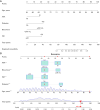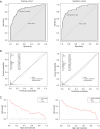Development and validation of a LASSO-based nomogram for predicting anastomotic leakage in elderly patients after laparoscopic gastrectomy
- PMID: 40672095
- PMCID: PMC12260994
- DOI: 10.21037/jgo-2024-897
Development and validation of a LASSO-based nomogram for predicting anastomotic leakage in elderly patients after laparoscopic gastrectomy
Abstract
Background: Anastomotic leakage (AL), a major postoperative complication following laparoscopic gastrectomy (LG), presents a critical diagnostic challenge in elderly patients, often resulting in life-threatening outcomes. This study aimed to develop and validate a risk prediction model to facilitate the early identification of AL in this population.
Methods: Retrospective data from 884 elderly patients diagnosed with gastric cancer who underwent LG were analyzed. The patients were randomly divided into training and validation cohorts in a 7:3 ratio. Clinically relevant predictors of AL were identified using least absolute shrinkage and selection operator (LASSO) regression and multivariate logistic regression analyses. A nomogram model was subsequently developed using these predictors. Model performance was evaluated and validated using the area under the curve (AUC) for discrimination, the Hosmer-Lemeshow test and calibration curve for accuracy, and decision curve analysis (DCA) for clinical applicability.
Results: The incidence rate of AL in the cohort was 13.6% (120/884). Five variables emerged as independent predictors of AL, including age, American Society of Anesthesiologists (ASA), diabetes, intraoperative blood loss, and prognostic nutritional index (PNI). The nomogram exhibited robust predictive accuracy, with AUC values of 0.870 [95% confidence interval (CI): 0.826-0.913] and 0.890 (95% CI: 0.828-0.952) in the training and validation cohorts, respectively. Calibration curves demonstrated a strong concordance between predicted and observed outcomes. DCA further indicated favorable clinical utility across a wide range of risk thresholds.
Conclusions: This study developed a LASSO-derived nomogram that incorporates five routinely assessed perioperative variables (age, ASA score, diabetes, intraoperative blood loss, and PNI) as a reliable tool for predicting AL risk in elderly patients undergoing LG. The model demonstrated satisfactory accuracy, discrimination, and clinical efficacy, thus enabling early risk identification to guide targeted preventive interventions.
Keywords: Anastomotic leakage (AL); elderly; laparoscopic gastrectomy (LG); nomogram; prediction model.
Copyright © 2025 AME Publishing Company. All rights reserved.
Conflict of interest statement
Conflicts of Interest: Both authors have completed the ICMJE uniform disclosure form (available at https://jgo.amegroups.com/article/view/10.21037/jgo-2024-897/coif). The authors have no conflicts of interest to declare.
Figures




Similar articles
-
Development and validation of a nomogram model for predicting the occurrence of necrotizing enterocolitis in premature infants with late-onset sepsis.Eur J Med Res. 2025 Jul 8;30(1):595. doi: 10.1186/s40001-025-02857-0. Eur J Med Res. 2025. PMID: 40629472 Free PMC article.
-
Building a risk prediction model for anastomotic leakage postoperative low rectal cancer based on Lasso-Logistic regression.BMC Gastroenterol. 2025 Jul 30;25(1):540. doi: 10.1186/s12876-025-04128-y. BMC Gastroenterol. 2025. PMID: 40731389 Free PMC article.
-
Development and Validation of a Nomogram-Based Risk Prediction Model for Diabetic Retinopathy in Elderly Adults with Type 2 Diabetes Mellitus.Diabetes Metab Syndr Obes. 2025 Jul 25;18:2509-2523. doi: 10.2147/DMSO.S530424. eCollection 2025. Diabetes Metab Syndr Obes. 2025. PMID: 40734942 Free PMC article.
-
The comparative and added prognostic value of biomarkers to the Revised Cardiac Risk Index for preoperative prediction of major adverse cardiac events and all-cause mortality in patients who undergo noncardiac surgery.Cochrane Database Syst Rev. 2021 Dec 21;12(12):CD013139. doi: 10.1002/14651858.CD013139.pub2. Cochrane Database Syst Rev. 2021. PMID: 34931303 Free PMC article.
-
Drugs for preventing postoperative nausea and vomiting in adults after general anaesthesia: a network meta-analysis.Cochrane Database Syst Rev. 2020 Oct 19;10(10):CD012859. doi: 10.1002/14651858.CD012859.pub2. Cochrane Database Syst Rev. 2020. PMID: 33075160 Free PMC article.
References
LinkOut - more resources
Full Text Sources
